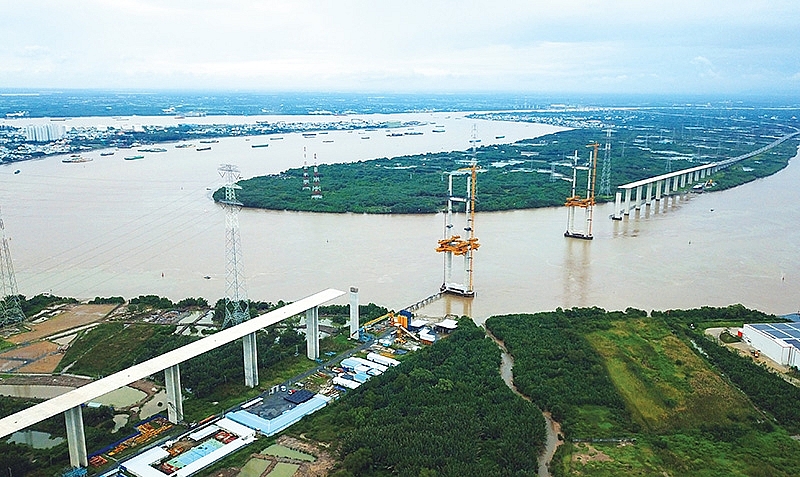Raising growth via public investment
 |
| The new funds will help to implement a series of major infrastructure projects nationwide, photo Le Toan |
Assigned by the government, Minister of Planning and Investment Nguyen Chi Dung last week reported to the National Assembly (NA) that the government has just fixed the VND2.75 quadrillion ($119.56 billion) public investment budget for 2021-2025, which will be adopted by the NA.
The total sum will include VND1.38 quadrillion ($60 billion) for the central budget, covering VND300 trillion (over $13 billion) in foreign capital, and VND1.08 quadrillion ($46.96 billion) in domestic capital, while localities will be allocated VND1.37 quadrillion ($59.56 billion).
The budget will be far larger than in 2016-2020 when it was VND2 quadrillion ($86.95 billion), including VND1.12 quadrillion ($48.69 billion) for the central budget (VND300 trillion [over $13 billion] in foreign capital and VND820 trillion [$35.65 billion] in domestic capital) as well as VND880 trillion ($38.26 billion) for localities.
“At present, the government is ordering the Ministry of Planning and Investment (MPI) to quickly work with ministries, central agencies, and localities to gather and revise their demands for state funding. Then their middle-term public investment plans for 2021-2025 must be submitted to the government before being submitted to the 15th NA,” Minister Dung said, adding that more favourable conditions will be created for private investors to engage in public projects.
According to the MPI, over the next five years, the new funds, in addition to capital from private domestic and foreign investors, will help to complete the construction of the eastern cluster of the North-South Expressway, the national coastal road line, connection roads, airports, and seaports.
In June, the NA’s Standing Committee decided that three out of the eight expressway projects under the Eastern Cluster of the North-South Expressway project, will be funded from state coffers. These three projects include Mai Son-National Highway No.45 (63.4km), Vinh Hao-Phan Thiet (106km), and Phan Thiet-Dau Giay (98km). The state will pour an additional VND23.46 trillion (over $1 billion) into these projects.
According to the committee, these three projects, which are already under way, are of great importance and urgency for investment due to rising traffic demand. All of them had been planned for investment under the public-private partnership form.
“The new investment from the state and investors will contribute to reducing travel time for passengers and goods, saving fuel, paring down transport costs, and improving the economy’s competitiveness,” Minister Dung said.
“This will also contribute to expanding spaces for development, creating new land areas for production and business, and enhancing the effectiveness of maritime resources and economic development.”
At a macro level, new public investment will also help the country to hit the economic growth target of 6.5-7 per cent annually in 2021-2025. These rates are mentioned in the MPI’s draft Socioeconomic Development Plan for 2021-2025, under which by 2025, the per capita income will be $4,700-5,000, the GDP ratio of the processing and manufacturing industry will be over 25 per cent and digital economy will be 20 per cent. The draft will have to be submitted to the government before being tabled at the NA.
According to the Ministry of Finance, by the end of 2020 about VND633 trillion ($27.5 billion) of public investment must be disbursed. This includes VND470.6 trillion ($20.46 billion) this year and VND162.4 trillion ($7 billion) transferred from 2019.
From January to late September, 57 per cent of the public investment was disbursed, up 31 per cent on-year, with 23 localities having disbursement rates of over 60 per cent, including the northern provinces of Hung Yen (87.7 per cent), Ninh Binh (82.46 per cent), and Thai Binh (79.5 per cent).
“At the current speed of disbursement, we will likely reach 95-97 per cent of the plan, which is an important impetus for the country to hit a growth rate of at least 2 per cent this year,” said Pham Dinh Thuy, general director of the General Statistics Office’s Department for Industrial and Construction Statistics.
What the stars mean:
★ Poor ★ ★ Promising ★★★ Good ★★★★ Very good ★★★★★ Exceptional
Related Contents
Latest News
More News
- Ho Chi Minh City hits $8.37 billion in FDI (December 29, 2025 | 08:28)
- Tax sector wraps up 2025 and sets priorities for next year (December 25, 2025 | 14:00)
- Heavy industries set for pilot greenhouse gas quotas (December 25, 2025 | 10:00)
- $250 million deal targets women-owned SMEs, sustainable agriculture (December 22, 2025 | 17:40)
- UOB sees Vietnam growth easing in fourth quarter (December 22, 2025 | 17:39)
- Government moves to establish International Financial Centre (December 21, 2025 | 21:00)
- Vietnam's IFC to target global investment flows (December 21, 2025 | 18:00)
- Ha Tinh breaks ground on major Vingroup industrial and energy projects (December 19, 2025 | 18:24)
- EVN launches major power infrastructure projects nationwide (December 19, 2025 | 18:17)
- VAL inaugurates second production line to meet domestic animal feed demand (December 19, 2025 | 16:37)

 Tag:
Tag:





















 Mobile Version
Mobile Version